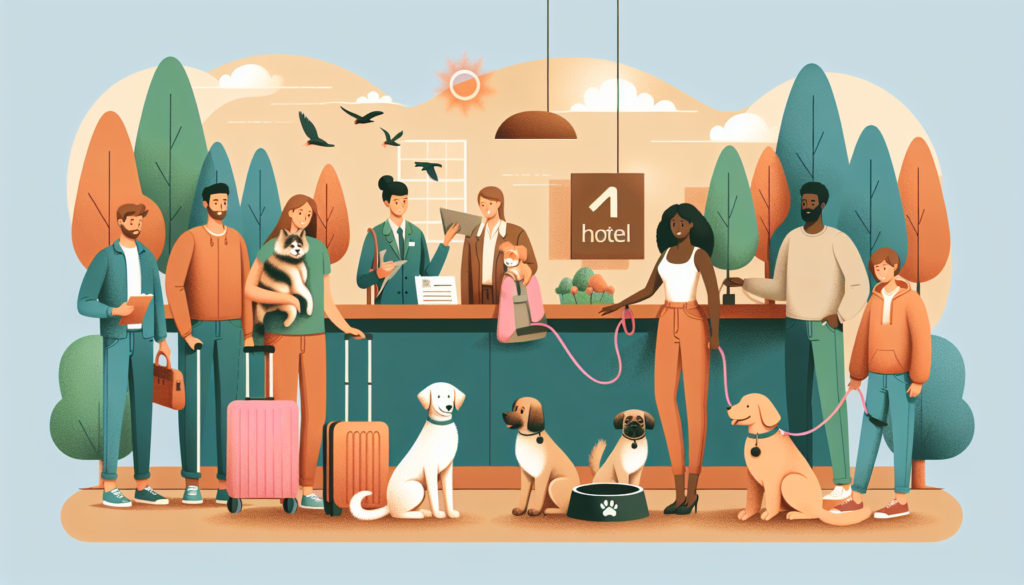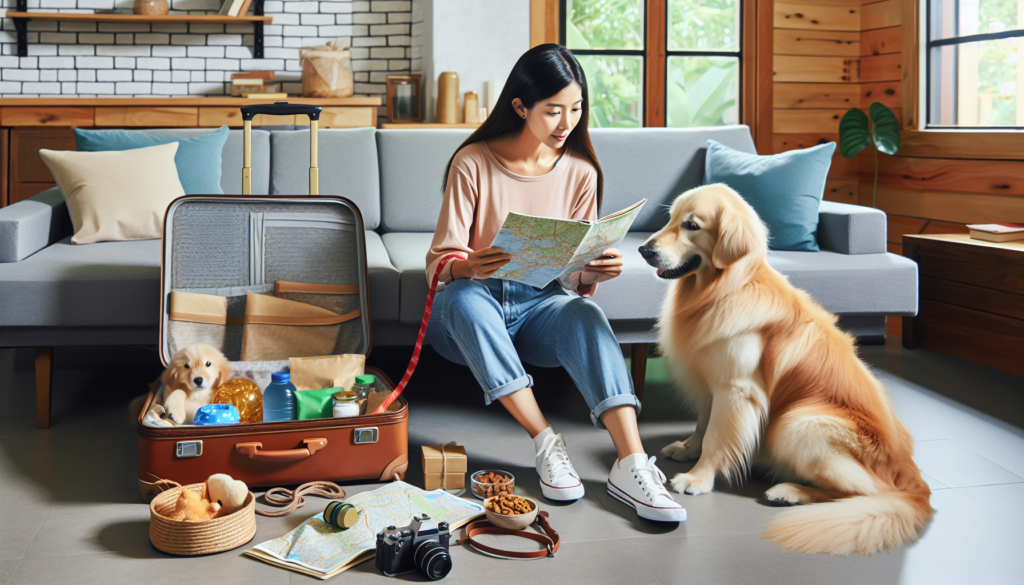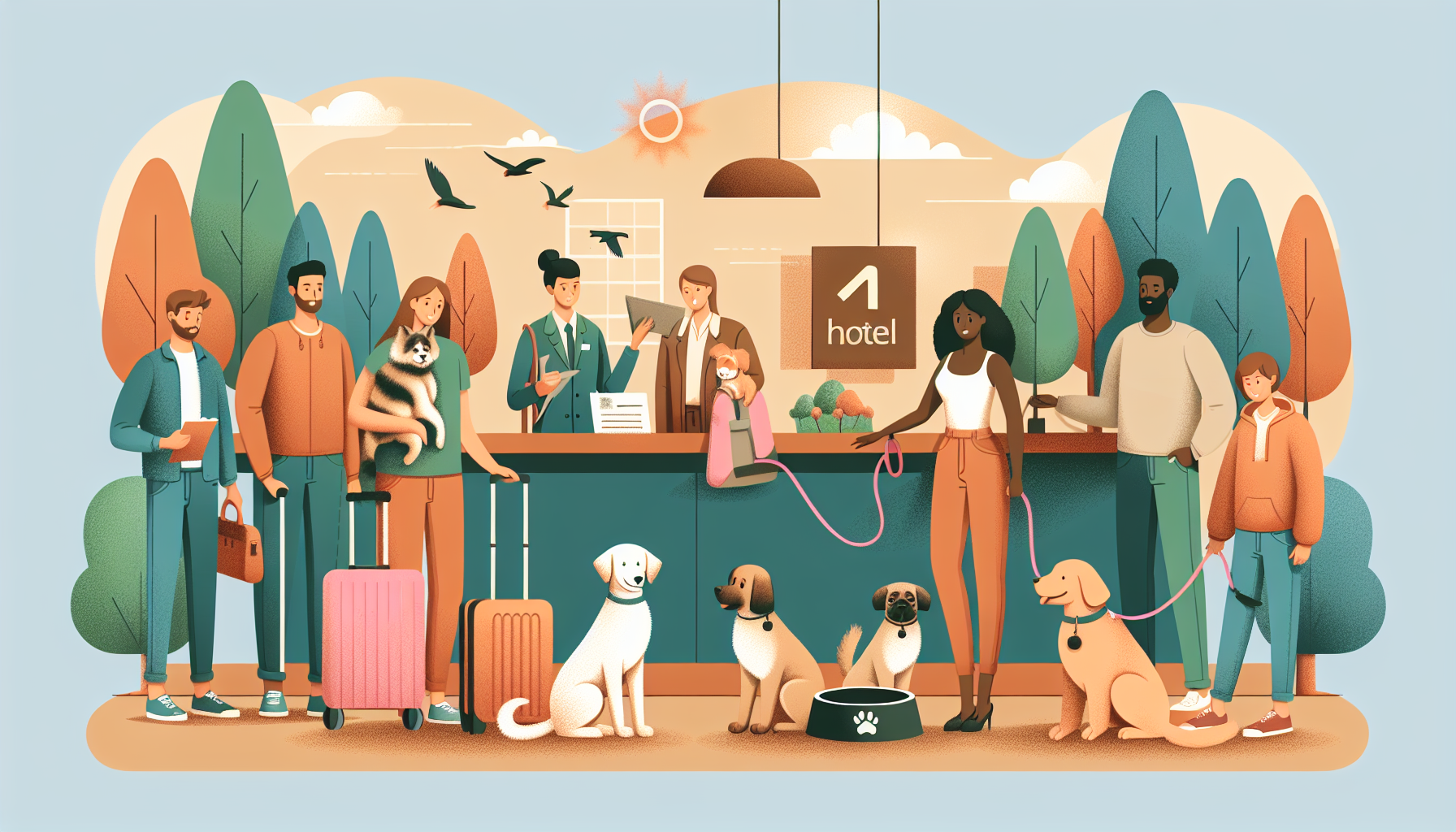Bringing your furry friend along on your next adventure can be a rewarding experience, but it requires careful planning and preparation. Whether you’re embarking on a road trip or hopping on a plane, these useful tips for traveling with pets will ensure a stress-free and enjoyable journey for both you and your beloved companion. From selecting the right travel crate to packing essentials to keep your pet comfortable, follow this guide to make your pet’s travel experience as smooth as possible.
Choosing the Right Mode of Transportation
To ensure a smooth and comfortable journey for your furry friend, it is important to choose the right mode of transportation. Consider your pet’s personality and needs when making this decision. Some pets may be more comfortable traveling by air, while others may prefer a long car ride. Research pet-friendly airlines, trains, or buses in order to find the option that best suits your pet.
Consider Your Pet’s Personality and Needs
Every pet is unique, and their personalities and needs should be taken into account when planning their travel. Some pets may be anxious or easily stressed, while others may be more laid-back and adaptable. Consider your pet’s temperament and their comfort level with different environments. This will help you determine which mode of transportation is best suited for them.
Research Pet-Friendly Airlines, Trains, or Buses
When traveling by air, it is important to research pet-friendly airlines that have policies and facilities in place to accommodate pets. Many airlines have specific regulations for pets, such as size and breed restrictions, as well as temperature and ventilation requirements. Similarly, if you plan to travel by train or bus, make sure to check if they allow pets on board and if there are any additional guidelines to follow.
Check the Pet Policy and Requirements
Before making travel arrangements, thoroughly read and understand the pet policy and requirements of the transportation company you choose. This includes checking if there are any specific carrier or crate requirements, documentation needed, or health and vaccination requirements for your pet. Adhering to these policies will help ensure a hassle-free journey for both you and your furry companion.
Plan Ahead for Long Trips
If you are embarking on a long journey with your pet, it is important to plan ahead and make necessary arrangements. Research and book pet-friendly accommodations along your route, and ensure there are ample opportunities for bathroom breaks and exercise. Pack extra supplies, such as food, water, and bedding, to keep your pet comfortable throughout the journey.
Preparing Your Pet for Travel
Before hitting the road or taking to the skies, it is essential to prepare your pet for the trip ahead. Follow these steps to ensure a smooth travel experience for your furry friend.
Visit the Vet for a Check-up
Schedule a visit to the vet well in advance of your travel date. The vet will conduct a check-up to ensure your pet is in good health and fit for travel. They will also assess if your pet requires any vaccinations or medications, and provide advice on managing any pre-existing conditions during the journey.
Ensure Proper Vaccinations and Medications
Confirm that your pet’s vaccinations are up to date before traveling. Depending on the destination and mode of transportation, certain vaccinations may be required. Additionally, discuss with your vet if your pet would benefit from any preventive medications, such as flea and tick preventatives, or medications to ease anxiety during travel.
Obtain Necessary Travel Documents
Certain modes of transportation and travel destinations may require specific travel documents for your pet. Be sure to obtain any necessary paperwork, such as health certificates or permits, well in advance of your trip. It’s important to note that some countries have quarantine or entry requirements for pets, so check the regulations of your destination beforehand.
Acclimate Your Pet to the Carrier or Crate
If your pet will be traveling in a carrier or crate, help them acclimate to it before the journey. Introduce the carrier gradually and make it a positive experience for your pet by associating it with treats or their favorite toys. This will help reduce anxiety and make them feel more comfortable during travel.
Packing Essentials for Your Pet
Having all the necessary supplies and essentials packed for your pet is essential to ensure their comfort and well-being during travel.
Food, Water, and Treats
Pack enough food and water for the duration of the trip, plus a little extra in case of any delays or unexpected circumstances. Use a travel-friendly, spill-proof container for water, and consider carrying portable food and water bowls for convenient feeding on the go. Don’t forget to pack your pet’s favorite treats to keep them happy during the journey.
Comfort Items and Familiar Scents
Include your pet’s favorite blanket or bedding in their carrier or crate to provide them with a sense of familiarity. Familiar scents can help calm their nerves in an unfamiliar setting. You can also pack a few favorite toys to keep them entertained during the journey.
Leash, Collar, and ID Tags
Always carry a leash, collar, and ID tags with up-to-date contact information for your pet. These are essential for keeping your pet safe and secure during travel, as well as for identification purposes in case they get lost. Microchipping your pet is also strongly recommended to increase the chances of a safe return if they ever become separated from you.
Pet Bedding and Blankets
If you are staying overnight at a hotel or rental property, ensure you have pet bedding and blankets to make your furry friend feel comfortable and at home. Having familiar scents and a cozy place to rest will help alleviate any stress or anxiety they may experience in an unfamiliar environment.
First Aid Kit for Pets
Prepare a pet-specific first aid kit that includes essential items such as gauze, antiseptic solution, tweezers, and any necessary medications. Familiarize yourself with basic pet first aid procedures so you can quickly respond to any minor injuries or health issues that may arise during the journey.

Safety Measures During Travel
Ensuring your pet’s safety should be a top priority when traveling. Here are some important safety measures to follow during the journey.
Secure Your Pet Properly
Whether you are traveling by car or other means, it is crucial to properly secure your pet to prevent injury or escape. For car travel, use a pet-friendly harness or secure them in a carrier that is properly fastened. In other modes of transportation, follow the guidelines provided by the carrier or transport service to ensure your pet’s safety.
Avoid Leaving Your Pet Unattended
Never leave your pet unattended in a car or any other mode of transportation, especially in extreme weather conditions. Even a short period of time can result in heatstroke or other serious health issues. If you need to leave the vehicle or transport for any reason, make sure someone trustworthy is with your pet or consider using pet-friendly establishments that allow pets inside.
Never Let Your Pet Stick Their Head Out of Windows
While it may seem tempting, it is important to never let your pet stick their head out of car windows or other openings during travel. This can be extremely dangerous and increase the risk of injuries from debris, bugs, or sudden stops. Keep windows securely closed or use pet-specific travel accessories, such as window screens or barriers, to ensure their safety.
Maintain a Comfortable Temperature
Pets are susceptible to temperature extremes, so it is crucial to maintain a comfortable environment for them during travel. Keep the vehicle or carrier at a moderate temperature and avoid exposing them to direct sunlight or drafts. If traveling by air or train, check with the transport service about temperature control measures for pets.
Keep Your Pet Calm and Relaxed
Travel can be stressful for pets, so it’s important to do everything you can to keep them calm and relaxed. Play soft music or use white noise to mask any unfamiliar sounds. Use pheromone sprays or diffusers, such as products containing synthetic versions of feline facial pheromones, to help reduce anxiety. Speak to your vet about natural calming aids or medications if needed.
Managing Pets’ Bathroom Needs
Pets have bathroom needs just like humans, and it’s essential to make arrangements for them during travel.
Schedule Regular Bathroom Breaks
Plan for regular stops to allow your pet to use the bathroom and stretch their legs. Dogs typically need more frequent breaks than cats. Research pet-friendly rest stops or parks along your route where your pet can safely relieve themselves and get some exercise.
Carry Portable Waste Disposal Bags
Always carry portable waste disposal bags to clean up after your pet. Dispose of the waste in designated bins or containers to keep the environment clean and hygienic.
Use Pet-Friendly Rest Stops or Parks
When stopping for bathroom breaks or exercise, choose pet-friendly rest stops or parks. These places often provide designated areas for pets to relieve themselves and may have additional amenities such as water stations and walking trails. Remember to pick up after your pet to be considerate to others.
Train Your Pet to Use Pee Pads or Portable Litter Boxes
If you are traveling long distances or to areas where bathroom breaks may be limited, consider training your pet to use pee pads or portable litter boxes. This can be especially useful for cats or smaller dogs that may find it challenging to find suitable outdoor options while on the go.
Feeding and Hydrating Your Pet
Proper nutrition and hydration are important for your pet’s well-being during travel. Follow these tips to ensure they remain healthy and comfortable.
Stick to Your Pet’s Regular Feeding Schedule
Stick to your pet’s regular feeding schedule as much as possible during travel. Sudden changes in diet or meal times can upset their stomachs and lead to gastrointestinal issues. If you need to adjust the timing or amount of their meals, do so gradually in the days leading up to the trip.
Pack Sufficient Food and Water
Always pack enough food and water to last the duration of the journey. Consider any potential delays or unexpected circumstances, and factor in extra supplies accordingly. Use travel-friendly, spill-proof containers for food and water storage to prevent any messes or spills.
Avoid Overfeeding to Prevent Motion Sickness
Some pets are prone to motion sickness, especially during car rides. Avoid overfeeding your pet before traveling to prevent nausea and discomfort. Stick to small, light meals and wait until after the journey to feed them a full meal.
Use Spill-Proof Food and Water Containers
Invest in spill-proof food and water containers to avoid any messes or accidents during travel. These containers are designed to prevent spills and leaks, ensuring your pet’s meals and hydration remain intact even during bumpy rides or turbulence.

Ensuring Your Pet’s Comfort
Creating a comfortable environment for your pet is crucial to minimize stress and keep them at ease during travel.
Create a Familiar Environment
Bring along familiar items from your home, such as your pet’s bedding, blankets, toys, or even an unwashed T-shirt with your scent on it. These familiar scents will help your pet feel more secure and at ease in unfamiliar surroundings.
Allow Your Pet to Have Their Own Space
Whether traveling by car, plane, or train, ensure your pet has their own space where they can relax and feel secure. If using a carrier or crate, place familiar bedding and toys inside to create a cozy den-like environment. If your pet prefers to travel with you openly, consider using a pet seat or harness to provide a safe and comfortable space.
Keep Noise and Distractions to a Minimum
Pets can be sensitive to noise and distractions, so try to keep their environment as calm and quiet as possible during travel. Reduce external noises by using sound-cancelling or soft music. Avoid sudden loud noises that may startle or stress your pet.
Use Calming Aids for Anxious Pets
If your pet is prone to anxiety or stress during travel, consider using calming aids. There are various natural and holistic remedies available, such as herbal supplements, pheromone sprays or diffusers, or anxiety wraps. Consult your vet for recommendations based on your pet’s specific needs.
Pet-Friendly Accommodations
When traveling with a pet, it is essential to research and book pet-friendly accommodations in advance.
Research and Book Pet-Friendly Hotels or Rentals
Not all hotels or vacation rentals are pet-friendly, so it is crucial to research and book accommodations that welcome your furry friend. Look for hotels that specifically cater to pets or have designated pet-friendly floors or rooms. If renting a vacation home, confirm with the owner or property management company that pets are allowed.
Check for Amenities and Restrictions
Before booking, check for amenities offered for pets, such as pet beds, bowls, or even pet-sitting services. Additionally, inquire about any restrictions or rules related to pets, such as weight limits, breed restrictions, or additional fees.
Ask About Additional Charges or Deposits
Many pet-friendly accommodations may have additional charges or require a pet deposit. Familiarize yourself with the specific costs and policies to avoid any surprises during check-in or check-out. Some establishments may refund the deposit upon inspection of the room, while others may apply it towards cleaning fees.
Keep Your Pet’s Behavior Under Control
When staying in a hotel or rental property, it is important to keep your pet’s behavior in check and be considerate of other guests. Follow any designated areas or rules for pet walking and toileting. Be mindful of noise and disturbances caused by your pet, and clean up after them to maintain a clean and pleasant environment.
Exploring New Environments with Your Pet
If you are traveling to new destinations with your pet, do your research to ensure a safe and enjoyable experience for both of you.
Research Pet-Friendly Places and Activities
Before arriving at your destination, research pet-friendly places such as parks, beaches, or hiking trails. Look for activities that you and your pet can enjoy together, such as pet-friendly cafes or shops. Keep in mind that local rules and regulations may apply, so comply with any leash laws or restrictions.
Follow Local Rules and Regulations
Make sure to familiarize yourself with any local rules and regulations regarding pets. Each destination may have different requirements, such as specific leash laws or restrictions on where pets are allowed. Respect these rules to maintain a positive experience and avoid any legal issues.
Always Use a Leash in Public
When exploring new environments, it is important to always use a leash when in public. Even the most well-behaved pets can become overwhelmed or distracted in unfamiliar surroundings. Using a leash not only keeps your pet safe but also ensures that they don’t wander off or disturb other people or animals.
Be Mindful of Your Pet’s Comfort and Safety
While exploring new environments, keep your pet’s comfort and safety in mind. Be aware of potential hazards such as hot pavement, poisonous plants, or bodies of water that may be unsafe for swimming. Provide plenty of water, breaks, and shade to prevent overheating during outdoor activities.
Dealing with Pet Anxiety and Stress
Traveling can sometimes cause anxiety and stress in pets. Here are some tips on how to manage and alleviate these feelings.
Recognize Signs of Anxiety in Your Pet
It is important to recognize signs of anxiety or stress in your pet, such as excessive panting, pacing, restlessness, vocalizations, or refusal to eat or drink. If you notice any of these signs, try to identify the source of their distress and make necessary adjustments to their environment or routine.
Use Calming Techniques and Distractions
When your pet shows signs of anxiety or stress, use calming techniques and distractions to help alleviate their discomfort. Playing soft music, offering comforting scents, or engaging them in calming activities like puzzle toys can redirect their focus and promote relaxation.
Consider Natural or Holistic Remedies
There are natural or holistic remedies available that can help calm anxious pets. Some options include herbal supplements, essential oils (used safely and under guidance), or natural anxiety-relief sprays or drops. Always consult with your vet before using any remedies and follow their recommendations.
Talk to Your Vet about Medications
In some cases, pets may require anti-anxiety medications to help them cope with travel-related stress. Consult your vet if you feel that your pet’s anxiety is severe or if natural remedies have not been effective. Your vet can recommend the appropriate medication and provide guidance on dosage and administration.
Traveling with your pet can be a rewarding and enjoyable experience, as long as you take the necessary precautions and plan ahead. By considering your pet’s personality and needs, preparing them for travel, following safety measures, and prioritizing their comfort, you can ensure a successful journey for both you and your furry companion. Remember to do your research, stay organized, and always prioritize your pet’s well-being throughout the entire travel process. Bon voyage!

